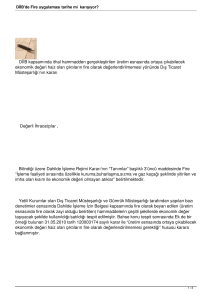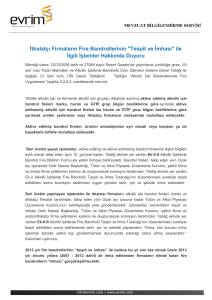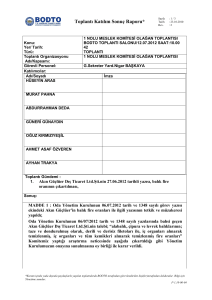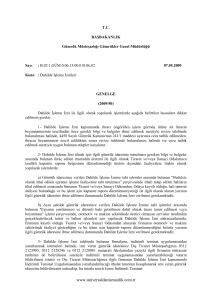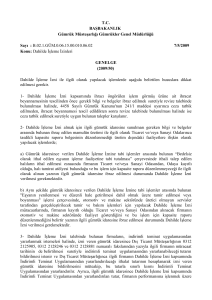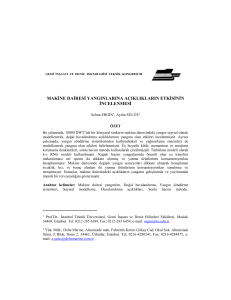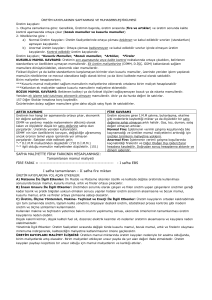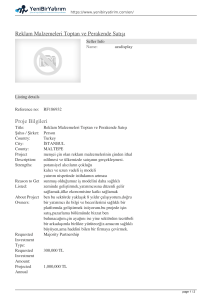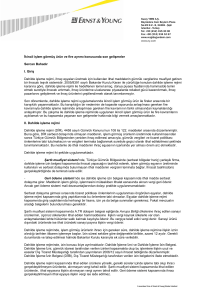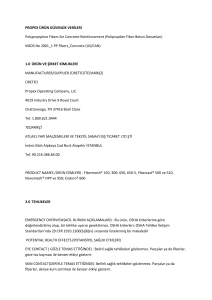Uploaded by
dursun.bas
Modeling Fire Behaviour and Risk
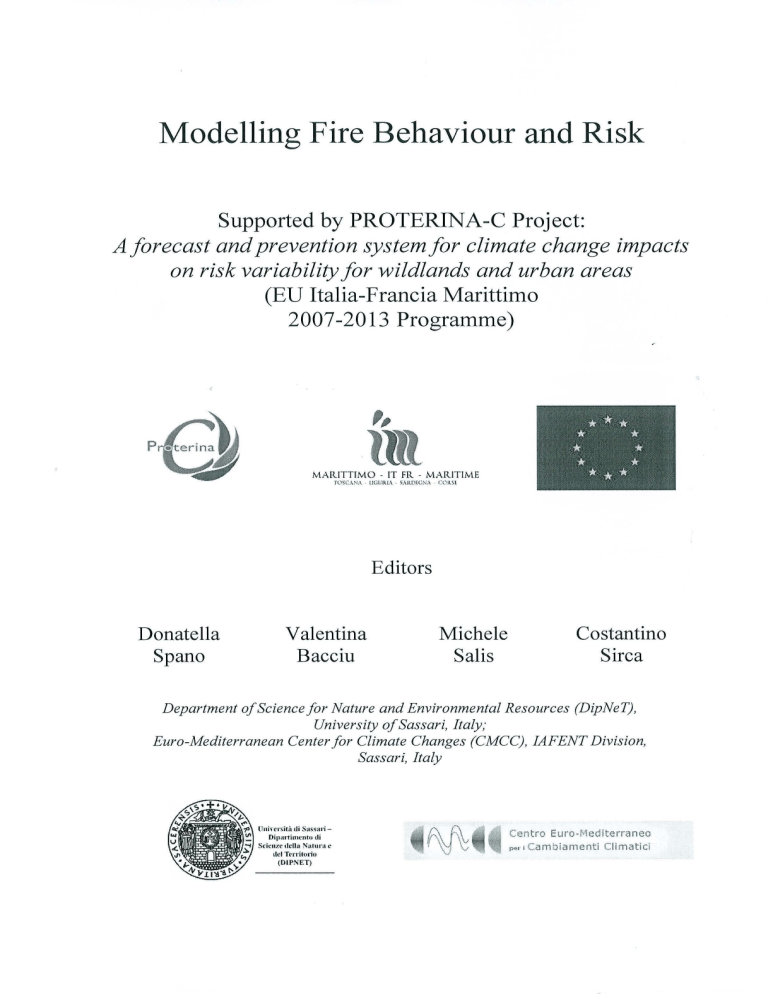
Modeliing Fire Behaviour and Risk
Supported by PROTERINA-C Project:
A forecast and prevention system for elimate change impacts
on risk variability for wildlands and urban areas
(EU Italia-Francia Marittimo
2007-2013 Programme)
,,
p
M A RITTfMO - IT FR 1'0St:.\ Nı\
• UGtHUA .
ı'v\ARITi ı'vtE
• C\.'-R Sf.
5oAR.DH.~ N,\
Editors
Donatella
Spano
Valentina
Bacciu
Michel e
Sali s
Costantino
Sirca
Department of Science for Nature and Environmental Resources (DipNeT),
University of Sassari, Italy;
Euro-Mediterranean Center for Climate Changes (CMCC), IAFENT Division,
Sassari, Italy
Centro Euro -Mediterranco
.,.,, Cam b1 arnenti Climatici
Historical relationship between climate and fire regime in
Köprüçay Basİn (Antalya, Turkey)
Kavgaci
Asagı
A.\ Salis M. 2'3 , Arca B. 4 , Cosgun U.\ Gungoroglu C. 1, Spano D. 2'3
1
Southwest Anatolia Forest Research Institute, Pob 264 07002 Antalya, Turkey
D~artment ofSciencefor Nature and Environmental Resources (DipNeT) , Sassari, Italy,·
Euro-Mediterranean Center for Climate Changes, IAFENT Division, Sassari, Italy,·
4
National Research Council of Italy, Institute of Biometeorology (CNR-IBIMET), Sassari,
Italy
2
alikavgacil977@yahoo. com
Abstract
In this work, we analyzed fire regime, climatic trend and relationships between fire and
climate in the Asağı Köprüçay basin (Antalya, Turkey), an area of about 205 ,000 hectares.
The study area is intensively affected by forest fires. Since the histarical data on fires were
consistent in detail after 1979, we analyzed the histarical period ı979-2009. Regarding the
climate analysis, data of four meteorological stations representing the different climatic
conditions of the study area were taken into consideration. Daily records of maximum,
mean and minimum temperatures, precipitation, wind speed and direction, relative
humidity were used for the analysis. In the study period, mean and minimum temperatures
showed a statistically significant increasing trend with time. The trends of fire number,
bumed area and meteorological data were analyzed by using correlation and linear
regression techniques. Regarding the histarical trends in terms of fire number, no
statistically significant trends were observed, because of the high inter-annual variability of
the data. The bumt areas showed a general increasing trend that is not statistically
significant. No statistically significant correlation between fire number and bumt area was
observed. The relationships between weather parameters and the main indicators of fire
activity: fire days (FD, at least ı fire per day), large fire days (LFD, at least 20 hectares per
day), multiple fire days (MFD, more than ı fire per day), were investigated by the
application of the logistic regression. The histarical relationship between weather variables
and the main indicators of the fire activity (FD, LFD, MFD) were analyzed by a set of
logistic regression models. In particular, 4 models provided the best combined response in
predicting the different fire activity indices on both annual and seasonal data. The different
models were characterised by low estimation accuracies for FD, while the best results were
obtained for LFD. Temperature and relative humidity are the weather variables mostly
correlated with the fire activity probability as predicted by the logistic models. An increase
in the accuracy was generally obtained where the 3 and 7 days minimum and maximum
average values were used instead of the daily mean values of the weather variables.
Keywords: Antalya, Climate, Fire, Logistic regression, Turkey.
.. ..
.
70
1. INTRODUCTION
Total forested areainTurkey is 21.5 millions of hectares (27.6% of allland) (Anon. 201 1).
The largest amount of forests is represented by Mediterranean type ecosystems such as
Pinus brutia forests and maquis, mainly dominated by Arbutus andrachne, Arbutus unedo,
Calicotome villosa, Ceratonia siliqua, Quercus coccifera, Myrtus communis, Phillyrea
latifolia, Pistacia terebinthus, Pistacia lentiscus, Spartium junceum, Styrax officinalis.
These fire prone ecosystems especially appear in southem and westem parts of Turkey.
Each year, many forest fires occur in these areas. Thousand hectares of forested areas are
affected by fires; additionally, they threat the rural and urban life. Forest fires are the most
important issues of the forestry management activities in south and westem Turkey. Big
amount of the budget dedicated to forestry practices are spent for fire prevention and
suppression efforts. In this context, investigations on fires and on the related issues are
crucial in order to improve fire management. Weather conditions are one of the most
important factors that influence forest fires (Pausas, 2004) and directly affect fire ignition,
spread and severity. Because of that, the relationships between forest fires and weather
conditions were analyzed in this work and for this goal the trends of forest fires and
weather factors were firstly defined and then the relationships between these components
were analyzed for the study area.
2.
MATERIAL AND METHODS
In Turkey, one of the areas most intensively affected by forestfiresis the Antalya province;
the Aşağı Kopruçay basin, with 8 forest provinces and 80 forest villages, was defined as the
study area in the work (Figure 1). The study area is approximately 205,000 hectares of
which about 120,000 hectares are represented by forests, and about 70,000 hectares by
agricultural areas. The main vegetation type in the study area is characterized by Pinus
brutia forests that have been intensively affected by fires.
The fire data from the period
1979-2009 were used in this
work. During this period,
1,084 forests fires occurred in
the area and about 30,000
hectares were bumed. The
years with the highest bumed
areas were 2008, 1994, 1979
and 2000 respectively. The
year 2008 was especially
important since the largest fire
of the history of Turkey was
observed in this year, with a
Figure I . Map of the study area. Legend indicates the
bumed area of more than
altitudinal variation
15,000 hectares. Maving to the
meteorological analysis, we
used the data of Antalya and Manavgat weather stations, which represent an indicator of the
typical weather conditions of the lowlands and coasts of the study area, where the fires are
mostly concentrated. The trends of fire number, burned area and meteorological data were
analyzed by correlation and linear regression techniques. Regarding the relationship
;.ı-m..O>a
i> "
..
71
between histarical weather and fires, only the meteorological data showing important
correlations with fire data were reported in the text. The weather data were analyzed
considering both the average annual and seasonal (July-October) values, in order to
investigate the histarical trends and the relationship between fires and weather. The
analyses were carried out with the R software.
The relationships between the weather parameters and the main indicators of fire activity:
fire days (FD, at least ı fire per day), large fire days (LFD, at least 20 hectares per day),
multiple fire days (MFD, more than ı fire per day) were detected by the application of the
logistic regression, w hi ch is one of the main methods use d in this field (Maıtel et al. ı 987,
Andrews et al. 2003 ). Du e to the large num b ers of weather parameters, the first step s of the
analysis were conducted by automatic methods, mainly by the stepwise regression, in order
to find the weather parameters characterized by high values of significance. The analysis
was conducted (i) on daily basis using the mean values of the weather parameters, and (ii)
on a moving window of 3 days and 7 days calculating the maximtım, the minimum and the
summation of the values observed during the period. The estimates provided by the logistic
regressions are characterized by a large number of statistical indicators, and the evaluation
of the best models <can be obtained only by an interactive process considering an integrated
response between different parameters, mainly the classification accuracy, the HosmelLemeshow test, and the values of the coefficient of determination (r\ Two different groups
of estimations were realized, considering two different sets of daiJ; data, covering the entire
years (1 st set) and only the period from May to October (2n set). The two set were
characterized by large differences in number of records ( ~ ı 1,300 for annual data and ~
3,800 for seasonal data) and in the variability of the weather parameters; therefore, the
statistics are affected by these aspects and the accuracy of the models should be analysed
separately for annual and seasonal data. The use of the interactive methods (mainly
stepwise regression) produced logistic models characterized by a large number of
independent variables, and therefore may lead to a limited accuracy in predicting the values
of the fire danger indices on new data not used in this developing phase. In addition these
models, and the values of their independent variable coefficients, are characterized by a lo w
explanatory content and by a high degree of cross correlation between variables
characterised by similar physical nature. For this reason, a limited set of models were
developed by manual selection of the independent variables by using both the results of the
statistical tests and the evaluation of the accordance with the physical and theoretical
expectations.
3.
RESULTS AND DISCUSSION
Regarding the histarical trends of fire number, it is important to highlight that no
statistically significant trends were observed, because of the high inter-annual variability of
the data. Similarly the burnt areas in time showed an increasing trend that is not statistically
significant. When we look to the correlation between fire number and burnt area, there is an
increasing correlation, which is not statistically significant. This correlation did not show a
statistically significant trend even if the big fire of 2008 is excluded.
Regarding the trend of weather parameters in time, maximum temperature, relative
humidity and cumulated rain (precipitation) did not show relevant statistical trends. On the
other hand, the trends of mean and minimum temperatures showed increases in time and
these changes were also statistically significant (Figure 2, 3). The most frequent wind
.... "
72
directions were WNW, S, SSE and SSW and no significant trends for wind directions and
frequencies were observed for the study area. The conelations between fires and mean and
minimum temperatures were not statistically significant (Figure 4,5,6,7).
Tm in
Tıne an
:! i .5
24 .
r=
1
Rı\IS I: =O.S :! ü l
,\ 1 S E =O . ı.i82 4
i ç
;ı
i
..
o.ıuoz:-; -:! 99 .4 9
R1 =0.i62S
23 '
26.5
--
';' :ıı
1 ....
20
... ..
, .
r = o.o7 2.h: : . ı
ı v.H
Rl=0. 3 11-I
R.\ \ S E = 0 . ü ~ %
:\\Sf. =O A :! 9S
:!-1
li
23.3
.........................................
ı
......................._ ...................- .......__ ........................................................................_....~.........................................................
,)"'~~>:~.,~~'!;:~~~)>:~~:ı;~..,t-':;:~~:..~~~:l~~"5~~"5)':::~)"~·/ı~.ij)~i~·f!~-:~:..~)~{~-;:,'"~i~~':J~;;:~:~~>l~o,~~~~~~';J~::;~~~~>:J~
You
•
T ınm
-
t.iıı c .ı r~
(Tm in )
"Tın<':ı n
Figure 2. Minimum temperature trends:
linear regression (sfape
significance<O. 0001)
- Unc:ır c ( Tıll •'·' ll )
Figure 3. Mean temperature trends: finear
regressian (sfape significance <0. 0001)
TmaxvsBurntArea
Tınean
3!10 0
:ı:ıoo
·
ı ooo
•
300
~
vs BurntArea
30(10
2500
y= :H 9 .ti :lx · 9 i 09 A
R'=ıJ . II üti
1
1000
\'= :!OO. i ü - -1 6:1~ . 6
i'
5 (10
o
o
'o
30 .5
"
32
3 1.5
33
3 2 .5
33. 3
····-··---~
2:1 .5
.
.
....... ·········· ··-~-... ~· ····-·-·-·· " -+ ·
........... ~
2-1
2-1 .5
25
2 5.5
2ü
R• =0.0 501
······· + ··-~--~---·-·
Z6.5
Figure 4. Carrefatian between Tmax and
Burnt Area (excluding 2008)
Tmax vıı FireNumber
Tmean v.s Fire Number
70
r=
60
y=
60 .;
; . ı ti .J :!ıı. · ı n . Jz
..
30 -!
<O
.
:ıo ;
r
..
-J!
..
20 .
JO
20 .
10
o
J ı. J
32
32.3
-1 . 5S5 7 ıı;- S I .O:I -1
R'=O.ü9 15
R! : O. \ S3i
"
~
27.J
Figure 5. Carrefatian between Tmean and
Burnt area.
70
j
27
Mem Tcmpcnb:ı:re. (ec)
:ı :u
!
.j............. ·····~- ·····-·-·-······-··
2:1.5
~ -1 . 5
~u. :ı
Figure 7. Carrefatian between Tmean vs
Fire Number
Figure 6. Carrefatian between Tmax and
Fire Numb er
.... "
73
2 7.5
Regarding the relationships between the weather parameters and the main indicators of the
fire danger season (FD, LFD, MFD) we repoıied only a set of four logistic models
(Tab le 1), developed by manual selection of the variables. These models provided the best
combined response in predicting the different fire danger indices on both annual and
seasonal data (Table 2); the statistical parameters provided by the logistic regression
permitted to find the variables with the lower values of both the significance of the
coefficients and the prediction accuracy. Table 3 reported the parameter estimates for the
different models and dependent variables (FD, LFD, MFD).
Table 1. Independent variabfes included in the models. Tx3, Maximum value of the
temperature observed on the previous 3 days; Tx7, Maximum value of the temperature
observed on the previous 7 days,· Tn3, Minimum value of the temperature observed on the
previous 3 days,· Tn7, Minimum value of the temperature observed on the previous 7 days,·
RHx3, Maximum value of the relative humidity observed on the previous 3 days; RH•7,
Maximum value of the relative humidity observed on the previous 7 days; RHn7, Minimum
value of the relative humidity observed on the previous 7 days.
Model n°
Independent variables
1
Tx3, Tn7, RHx3, RHn7
Tx3,RHx3
2
3
Tx7,RHx7
4
Tn3,RHn3
On both the seasonal and the annual data the different models (Table 2) are characterised by
low estimation accuracies for the variable FD (correct classification lower than 33.6%),
while the best results were provided by the variable LFD (correct classification greater than
82.5%). In few cases the Hosmer and Lemeshow test provided values lower than the P
threshold of 0.05, and this is an indicator of lack of fit. This is true in particular for the
models predicting FD by using annual data. The lack of fit is an indicator on limited
generalizatian capacity on new data. The variable MFD is generally characterised by
intermediate performances, with values of correct classification lower than 79.6% on
annual data and 28.7% for seasonal data.
Table 2. Statistical parameters usedin order to define the accuracy of the models.
** Significance of the Hosmer and Lemeshow test (P=O. 05) indicaling no evide nce of a
lack o fit.
Model n°
Dependent
variable
Time step
Rescaled r2
% Concord.
ı
FO
Annual
o.ı8
2
3
4
"
"
"
"
"
"
"
"
o.ı8
79.00
78.50
o.ı6
77.ıo
o . ı8
Seasonal
0.06
0.05
0.03
0.07
79.00
63.20
62.30
58.30
64.90
ı
2
3
4
"
"
"
"
..
.. .
74
P-value
Hosmer
Lemeshow
Chi-Square
0.00
0.00
0.00
0.00
0.02
0.48**
0.58**
0.57**
% Correct
classifıc .
33.60
29.70
30.ıo
30.50
ı7.30
ı7.30
ı7.30
ı7.30
Tab/e 2. Continued
Mode l n°
Dependent
variable
Time step
Rescaled r
ı
LFO
Annual
2
3
4
"
"
"
"
"
"
"
0.28
0.23
ı
2
3
4
Seasonal
"
o . ı7
0.27
0.23
0.16
0.09
"
0.2ı
ı
MFO
Annual
o.ı9
2
3
4
"
"
"
"
"
"
o.ı3
0.20
Seasonal
o.ı2
"
o.ıo
"
"
0.05
O. ı3
ı
2
3
4
O. ı 8
2
% Concord.
85 .60
84.40
82 .20
86.30
85.70
80 .50
72 .90
83.50
84.30
83.30
79. ı o
85.50
74 . ı o
72.40
63 .70
76 .90
P-value
Hosmer
Lemeshow
Chi-S uare
0.84**
0.35**
0.17**
0.01
0.91 **
0.44**
0.92**
0.00
% Correct
classific.
0.2ı**
0.58* *
0.82**
0.84* *
0.50* *
o.ı7**
o.ı5**
0.63* *
94 .80
94.70
95.00
94 . lO
86.30
84 .70
83 .50
82.50
85 . ı o
85.20
79.60
84 .50
54.40
5 ı.50
28 .70
55.80
Tab le 3. Parameter estimates for the selected models.
Model no Time step
ı
2
3
4
ı
2
3
4
ı
2
3
4
ı
2
3
4
ı
2
3
4
ı
2
3
4
Annual
Annual
Annual
Annual
Seasonal
Seasonal
Seasonal
Seasonal
Annual
Ann ual
Annual
Ann ual
Seasonal
Seasonal
Seasonal
Seasonal
Annual
Annual
Ann ual
Annual
Seasonal
Seasonal
Seasonal
Seasonal
Oependent variable
FO
FO
FO
FO
FO
FO
FO
FO
LFO
LFO
LFO
LFO
LFO
LFO
LFO
LFO
MFO
MFD
MFO
MFO
MFO
MFO
MFO
MFO
Parameter estimates for the independent variables
-2.4ı +0.02•Tx3+0.10•Tn7-0.03•RHx3-0 .02•RHn7
-3 . 05+0 . ı2•Tx3-0 . 03•RHx3
-2.65+0 . ı2•Tx7 - 0 . 03•RHx7
-3 .22+0. ı2•Tn3 - 0 . 03•RHn3
- ı. ı4+0.09•Tx3 - 0.05•Tn7-0.02•RHx3-0 . 0 ı
•RHn7
-ı .37+0.06•Tx3-0 .03•RHx3
-0.9 ı +0 .05•Tx7-0.03•RHx7
-ı .00+0 .04•Tn3-0.03•RHn3
-4 .57+0.28•Tx3-0. ı 5•Tn7-0.03•RHx3-0.08•RHn7
-6.55+0 . ı 9•Tx3-0 .06•RHx3
-8. ı3+0 . 22•Tx7-0.04•RHx7
-4.29+0. ı 5•Tn3 -0. ı O•RHn3
-2.77+0.36•Tx3-0 .32•Tn7-0.02•RHx3-0.07•RHn7
-6 .91 +0 .20•Tx3-0.05•RHx3
-7 .27+0.20•Tx7-0.04•RHx7
-2.97+0. ı l•Tn3 -0.ll•RHn3
-3 .53 +0. ı 4•Tx3-0.02•Tn7 -0 .03• RHx3-0 .03• RHn7
-0 . ı 5+0. ı2•Tx3-0.05•RHx3
-4.87+0. ı4•Tx7-0.04•RHx7
-3 .33+0. ı ı •Tn3-0.08•RHn3
-2 .26+0 .2 ı •Tx3-0. ı 7•Tn7-0 .03•RHx3-0 .02•RHn7
-3 . ı 0+0. ı O•Tx3-0 .05•RHx3
-3 .02+0 .09•Tx7 -0 .04• RHx7
-ı .60+0.05•Tn3-0.07•RHn3
75
RI(
Temperature
and
relative U'D
l.O f"'" ........,.,..,.,....,,.,.... ,., ...,
., ...., 90 ;
humidity were the weather
0.9ı
variables mostly correlated 0.8[ ...
with the probability estimated 0.7; .
'
by the logistic models, and 0.6! ...
therefore with the fire danger
indices (LFD, MFD, FD). An
increase on accuracy was
.. . .. ;
)30
generally obtained where the 3
and 7 days minimum and
j 20
maximum values were used
0.0'.
=~ ı u
instead of the daily mean
210
220
140
25()
260
270
280
190
300
190
200
doy
of
the
weather
values
·----variables; this fact ıs an Figure 8. Estt.mation probability provided by the model n°
indicator of a sort of 3 us ing annual data (red line); year 1998; the daily values
summation of the short term
of the relative humidity are alsa plotted (black line) in
effects of weather variabtes on order to show the relationship with the actual events (LFD
fire danger indices; this is true events, blue vertical lines). In many cases the loı.,ver peak
in particnlar for the relative
value s of relative humidity are associated w ith the short
humidity; Figure 8 showed the
time probability offires.
pattern
of
the
relative
humidity, the relationship with the fire danger indices, and the associated pattern of
probability. Relative humidity and temperatures are the variables that explain most of the
variability of fire danger indexes, and showed a similar distribution of data and relationship
with the estimated probability (Figure 9 and Figure 10). The explanatory value of the wind
speed and precipitation is very low, and the stepwise regression found low values of
significance for their coefficients.
.
~
;
;
ı ;o
ıso
2~0
70..., -~·ı·· ·~!J~;·· -~:i·.~--,.;._-~·;;n~-~-;'"'; i ~
'",''.,• -.···, · . ...... _.. ,._. ..................... ,......... .......,··'"u'"~;~-0 ö?'..ô.
~111\lh~d 11 ..-.t>ı<.'>ıiiıy
Figure 9. Relationship betv.1een the
estimated probability provided by the
model 3 and the maximum values of the
relative humidity observed in the previous
7 days.
4.
Figure 1O. Relationship between the
estimated probability provided by the model 3
and the maximum values of the temperature
observed in the previous 7 days.
ACKNOWLEDGEMENTS
This work was partially funded by the European Union Seventh Framework Programme
(FP7/2007-2013) under Grant Agreement 243888 ("FUME" Project - Forest fires under
.. .. ..
76
climate, social and economic changes in Europe, the Mediterranean and other fire-affected
areas of the world)
5. REFERENCES
Andrews P.L., Loftsgaarden D.O., Bradshaw L.S., 2003. Evaluation ofjire danger rating
indexes using logistic regression and percentile analysis. International Journal of
Wildland Fire 12, 213-226.
Anonymous, 20 ı 1. State of Turkey 's fo res ts. General Directoı·y of Forestry, Turkey.
Marteli D.L., Otakel S., Stocks B.J., ı 987. A logistic model for predicting daily people
caıtsedjire occurrence in Ontario. Canadian Journal of Forest Research 17, 394-401.
Pausas J., 2004. Changes in fire and elirnafe in the Eastern Iberian Peninsula
(Mediterranean Basin). Climatic Change 63, 337-350.
77
